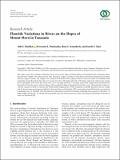| dc.description.abstract | This study reports the variations of fluoride ions in rivers on the slopes of Mount Meru in the northern part of Tanzania. More than 318 water samples were collected from Temi, Nduruma, Tengeru, and Maji ya Chai Rivers in both wet (mid-March and April) and dry (August) seasons. The samples were analyzed for fluoride levels using Ion Selective Electrode (ISE). The minimum and maximum average fluoride levels in the wet season were mg/l and mg/l, respectively, whereas the average lowest and highest levels in the dry season were mg/l and mg/l, respectively. Tengeru River had the lowest fluoride levels in both seasons, whereas Maji ya Chai recorded the highest fluoride levels in both seasons. The headwater of all rivers with the exception of Maji ya Chai met the World Health Organization’s (WHO) maximum acceptable fluoride levels of 1.50 mg/l and the downstream environment qualified for Tanzania Bureau of Standards (TBS) maximum permissible fluoride concentration in drinking water of 4.00 mg/l. Also, the laboratory experiments showed that fluoride containing rocks exposed to pH above 7.6 display high leaching of F− in solution which gradually increased with the increase in pH, indicating that dissolution of fluoride in water is a function of pH. | en_US |

